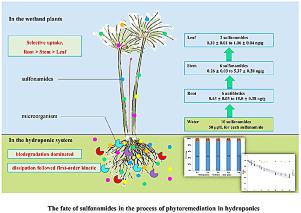Water Research ( IF 11.4 ) Pub Date : 2021-04-14 , DOI: 10.1016/j.watres.2021.117145 Jun Chen , Shuang-Shuang Liu , Lu-Xi He , Yu-Xiao Cheng , Pu Ye , Jie Li , Guang-Guo Ying , Yi-Jie Wang , Fang Yang

|
Phytoremediation has been proven to be an alternative in-situ treatment technique for sulfonamide polluted wastewater. However, the fate of sulfonamides in the phytoremediation process of multiple sulfonamides coexistence is unclear. Therefore, the possibility and mechanism of phytoremediation of ten sulfonamides by different wetland plants through hydroponics were investigated in this study. The phytoremediation rates of Σsulfonamides by different wetland plants were from 44.5% to 56.9%. Mass balance analysis showed that rhizosphere biodegradation (90.2% − 92.2%) dominated the phytoremediation of Σsulfonamides, while hydrolysis (7.63% − 8.95%) and plant uptake (0.05% − 0.17%) accounted for a small proportion. It is worth mentioning that the dissipation of the target sulfonamides in the hydroponic system followed the first-order reaction kinetic model, with half-lives of 13.3 d to 53.3 d, which are close to or even lower than that of aerobic biodegradation in river water, sediment, and piggery wastewater. Six of the ten spiked sulfonamides were detected in plant samples demonstrated that the selective uptake of plants under the coexistence of multiple sulfonamides. The distribution of sulfonamides (concentrations and uptake amounts) in plant tissues followed the sequence of root > stem > leaf in this study, but the distribution in stems and leaves needs further study. The uptake and rhizosphere biodegradation of Cyperus papyrus to sulfonamides are optimally resulting that its phytoremediation rate is significantly higher than other plants (p < 0.05), which indicates that plant species is one of the key factors affecting the phytoremediation efficiency of sulfonamides. These findings verify the feasibility of phytoremediation of sulfonamides, and provide new insights into the fate of sulfonamides in the process of phytoremediation.
中文翻译:

水培植物修复过程中磺胺的命运。
植物修复已被证明是磺胺污染废水的另一种原位处理技术。但是,尚不清楚多种磺酰胺并存的植物修复过程中磺酰胺的命运。因此,本研究探讨了不同湿地植物通过水培法修复十种磺酰胺的可能性和机理。不同湿地植物对磺胺类药物的植物修复率在44.5%至56.9%之间。质量平衡分析表明,根际生物降解作用(90.2%-92.2%)主导了磺酰胺的植物修复,而水解作用(7.63%-8.95%)和植物吸收(0.05%-0.17%)占很小的比例。值得一提的是,水培体系中目标磺酰胺的消散遵循一阶反应动力学模型,其半衰期为13.3 d至53.3 d,接近或什至低于河水中需氧生物降解的半衰期。 ,沉积物和养猪业的废水。在植物样品中检测到十种加标的磺酰胺中有六种表明多种磺酰胺共存下植物的选择性吸收。本研究中磺胺类药物在植物组织中的分布(浓度和吸收量)遵循根>茎>叶的顺序,但茎和叶中的分布有待进一步研究。根际生物量的吸收与降解。和养猪废水。在植物样品中检测到十种加标的磺酰胺中有六种表明多种磺酰胺共存下植物的选择性吸收。本研究中磺胺类药物在植物组织中的分布(浓度和吸收量)遵循根>茎>叶的顺序,但茎和叶中的分布有待进一步研究。根际生物量的吸收与降解。和养猪废水。在植物样品中检测到十种加标的磺酰胺中有六种表明多种磺酰胺共存下植物的选择性吸收。本研究中磺胺类药物在植物组织中的分布(浓度和吸收量)遵循根>茎>叶的顺序,但茎和叶中的分布有待进一步研究。根际生物量的吸收与降解。莎草纸浆对磺胺类药物的最佳抑制作用是其植物修复率显着高于其他植物(p <0.05),这表明植物种类是影响磺酰胺类植物修复效率的关键因素之一。这些发现证实了磺酰胺类植物进行植物修复的可行性,并为植物修复过程中磺酰胺类的命运提供了新的见解。











































 京公网安备 11010802027423号
京公网安备 11010802027423号